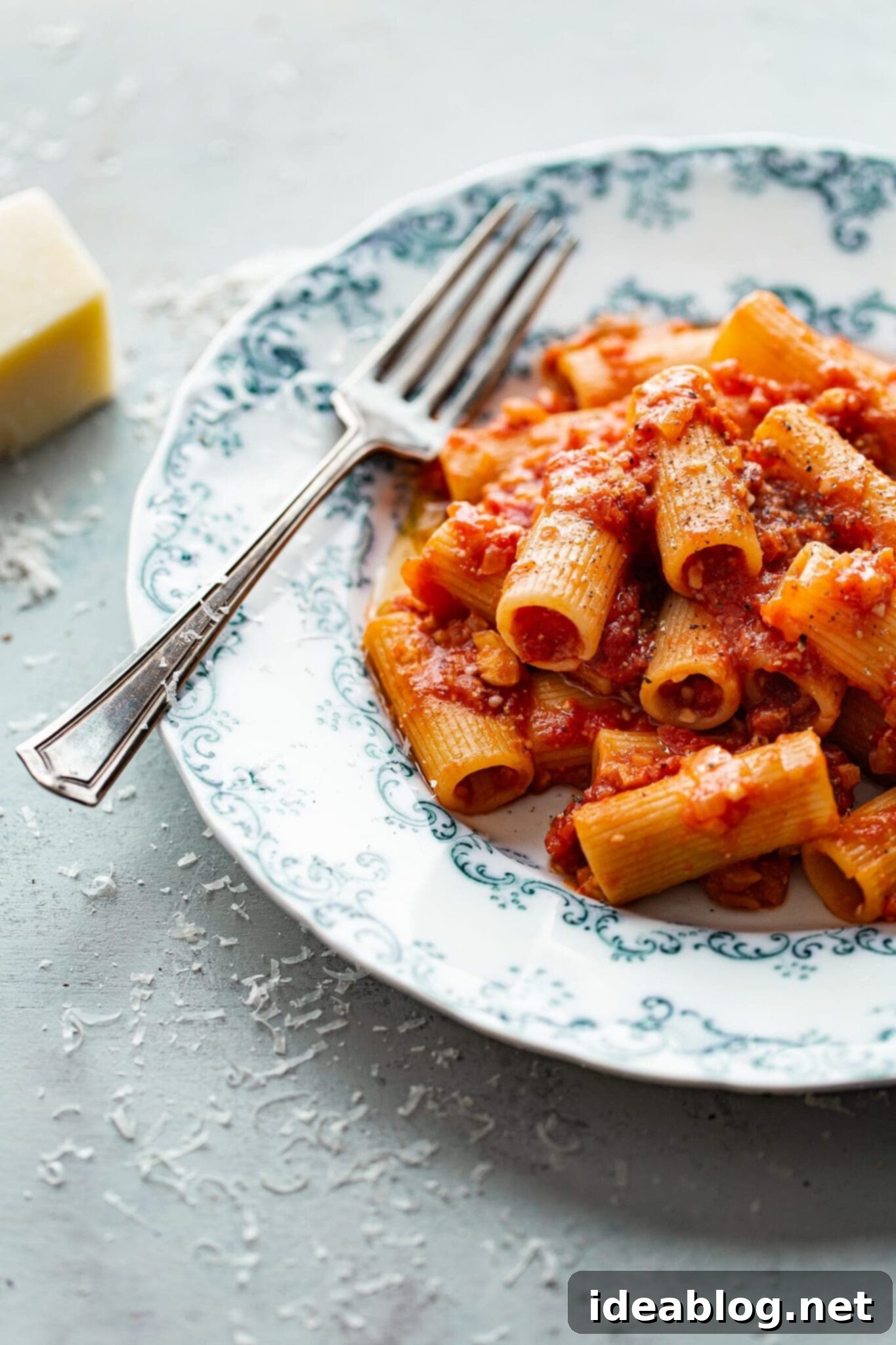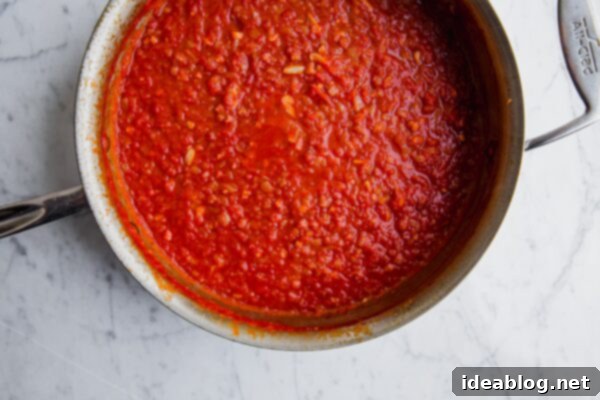Authentic & Easy Pasta Amatriciana: Your Go-To Spicy Italian Comfort Food
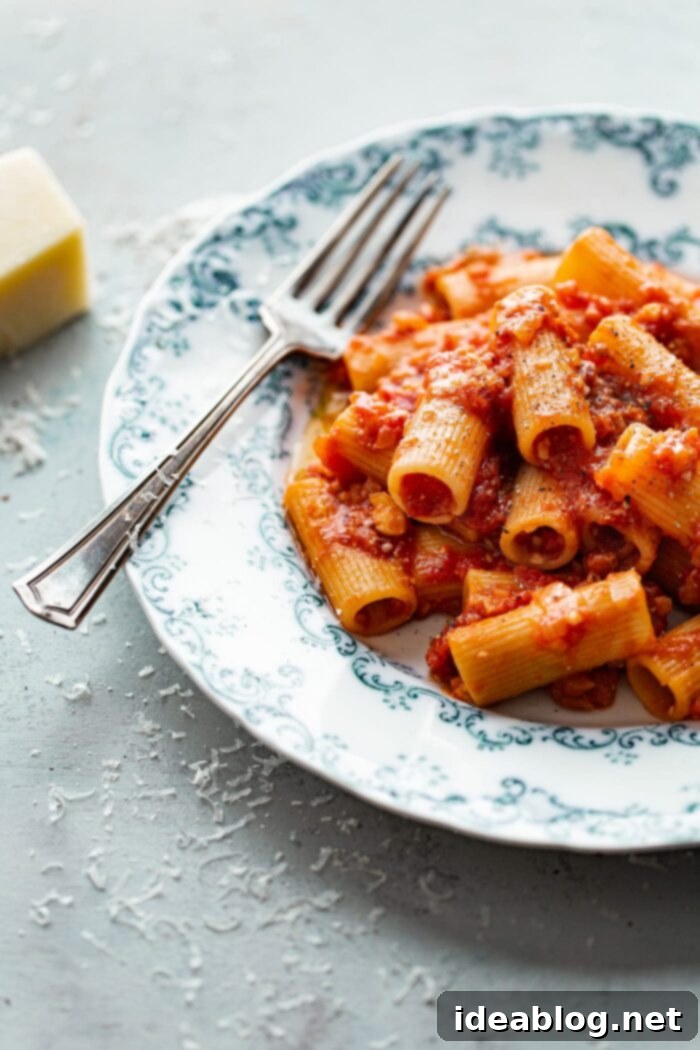
Delve into the vibrant flavors of Italy with this incredible Pasta Amatriciana recipe. While deeply rooted in tradition, this particular version offers a modern, accessible twist on the classic Italian sauce, otherwise known as all’amatriciana or simply matriciana. Hailing from the picturesque town of Amatrice in Lazio, Italy, Amatriciana sauce is a testament to the beauty of simple, high-quality ingredients coming together to create something truly extraordinary.
The history of Amatriciana is as rich and nuanced as its flavor profile, dating back to the 1700s. Traditionally, it’s a robust sauce built upon a foundation of cured pork (specifically *guanciale*), ripe canned Italian tomatoes, a kick of red pepper flakes, and the sharp, salty finish of Pecorino Romano cheese. Our rendition embraces these core elements while making a few thoughtful substitutions to ensure it’s both authentic in spirit and achievable for the home cook. We swap the harder-to-find guanciale for readily available, delicious pancetta, making this authentic Italian experience within reach for any weeknight.
If you have a love for hearty, immensely flavorful, and perfectly spicy pasta sauces, then today’s recipe is destined to become a new favorite in your culinary repertoire. This tomato-based masterpiece delivers a powerful punch of taste that evokes the feeling of dining at your favorite traditional Italian restaurant. But the absolute best part? This entire, restaurant-quality meal comes together in under 25 minutes, proving that incredible flavor doesn’t have to demand hours in the kitchen. Prepare yourself to come back for more; this Amatriciana is truly irresistible.
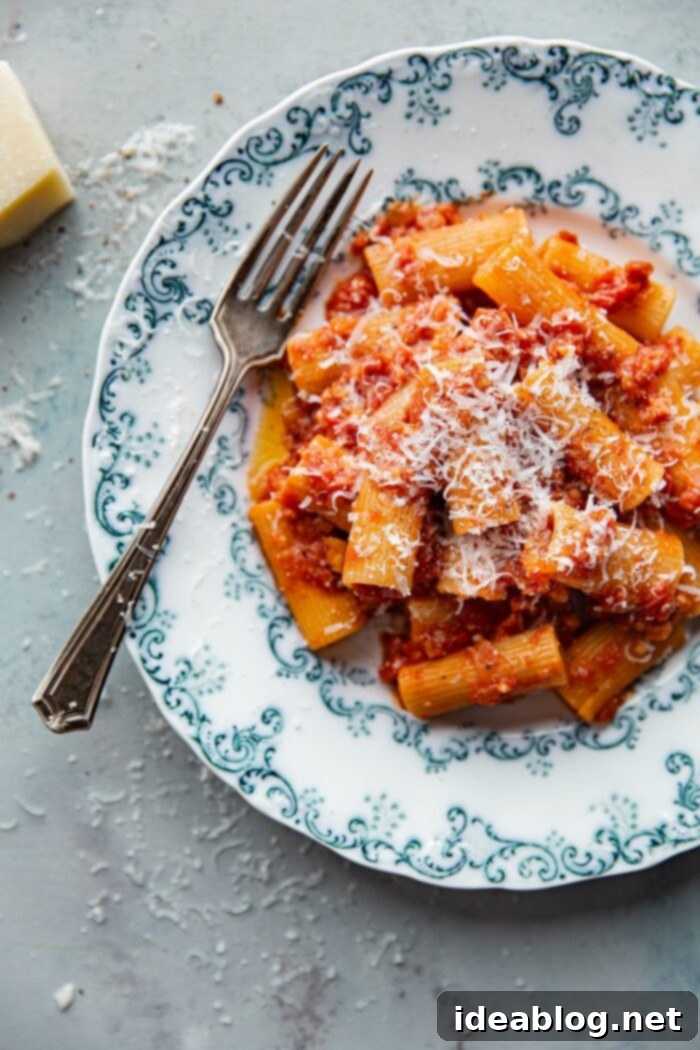
Why This Amatriciana Recipe Will Become Your Weeknight Favorite
Amatriciana isn’t just a pasta sauce; it’s a culinary experience that perfectly balances comfort with bold flavors. It consistently ranks as one of my personal favorite pasta sauces and a go-to for quick weeknight dinners, and for good reason. Its simplicity belies its incredible depth of flavor, proving that you don’t need a lengthy ingredient list or complex techniques to create something truly spectacular. Here’s why you’ll fall in love with this dish:
- Lightning Fast Preparation: From start to finish, this authentic Italian pasta dish can be on your table in under 25 minutes. It’s quicker than ordering takeout and infinitely more satisfying.
- Minimal Ingredients, Maximum Flavor: The recipe relies on a handful of high-quality, pantry-staple ingredients. This not only makes shopping easy but also highlights the purity of each component, allowing their individual flavors to shine through in a harmonious blend.
- Hearty & Satisfying: The rich tomato sauce, savory pancetta, and sharp Pecorino Romano create a wonderfully satisfying meal that fills you up without feeling heavy. It’s the ultimate comfort food for any season.
- Restaurant-Quality at Home: The robust, spicy, and umami-packed sauce tastes like it came straight from a trattoria in Rome. Impress your family and friends (or just yourself!) with this gourmet-level dish made in your own kitchen.
- Customizable Heat: The red pepper flakes offer a delightful warmth, but you have complete control. Adjust the quantity to suit your preference, from a gentle hum to a fiery kick.
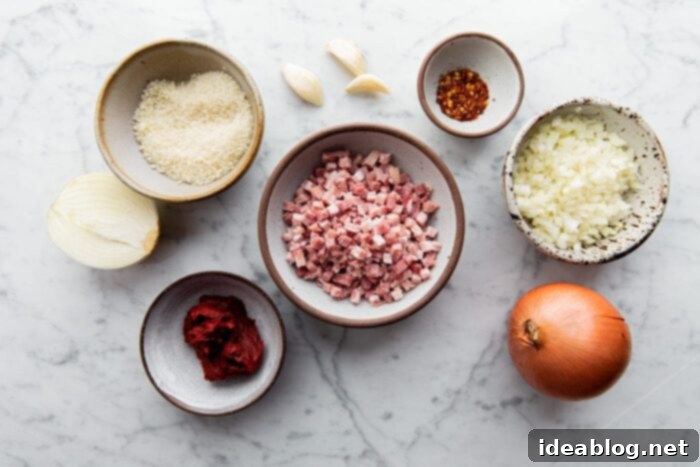
Crafting Perfection: Essential Amatriciana Ingredients
The magic of Amatriciana lies in its simple yet powerful ingredient list. Each component plays a crucial role in building the layered flavors that make this sauce so irresistible. Here’s a closer look at what you’ll need to create this classic Italian masterpiece:
- EXTRA VIRGIN OLIVE OIL: As a fundamental fat in Italian cooking, a good quality extra virgin olive oil provides the base for sautéing, infusing the initial flavors, and contributing to the overall richness of the sauce. Choose a mild to medium intensity olive oil that complements, rather than overpowers, the other ingredients.
- PANCETTA: While truly traditional amatriciana uses guanciale (cured pork jowl), which offers an unparalleled richness and unique flavor, pancetta (Italian bacon) is an outstanding and far easier-to-find substitute. Pancetta delivers that essential savory, salty, and slightly sweet pork flavor that is critical to the sauce’s character. I highly recommend dicing the pancetta into small, even pieces. This ensures that the crispy bits are well-distributed throughout every bite of the sauce, offering delightful textural contrast. However, feel free to adjust the dice size to your personal preference – some enjoy larger, chewier chunks.
- YELLOW ONION + GARLIC: Taking inspiration from many Roman amatriciana preparations, this recipe incorporates both sautéed yellow onion and garlic for an added layer of aromatic depth and complexity. The finely diced onion should cook down until it’s soft, translucent, and nearly dissolves into the sauce, contributing a subtle sweetness without being overtly present. The garlic, added later, offers its pungent, fragrant notes, essential for a well-rounded Italian sauce.
- DRIED RED PEPPER FLAKES: This recipe calls for a generous 1 teaspoon of dried red pepper flakes. This amount provides a decent, noticeable warmth and subtle heat that enhances the sauce without overwhelming the palate. It’s a key element for that classic “kick.” If you are sensitive to spicy foods, or prefer a milder flavor, feel free to decrease the quantity to 1/2 teaspoon or even less, and adjust to your taste preference. For those who love heat, you can always add a little more!
- TOMATO PASTE: A small amount of tomato paste is a secret weapon in this sauce. It’s cooked until slightly caramelized, which deepens its color and concentrates the tomato flavor, adding a vital layer of umami and richness that canned tomatoes alone cannot provide. Don’t skip this step – it’s crucial for the sauce’s robust character.
- CANNED ITALIAN TOMATOES: You’ll need one (28-ounce) can of high-quality crushed Italian tomatoes. Alternatively, you can use whole Italian peeled tomatoes and process them yourself until they are mostly smooth with a few rustic chunks remaining. The quality of your tomatoes significantly impacts the final taste of your Amatriciana. I strongly recommend seeking out San Marzano tomatoes if they are available to you, as they are known for their balanced sweetness, low acidity, and excellent flavor. My favorite reliable canned tomato brands include Bianca DiNapoli and Cento.
- PECORINO CHEESE: This is a non-negotiable, key ingredient that truly defines Amatriciana. Pecorino Romano is a hard, salty Italian sheep’s milk cheese, distinct from Parmigiano-Reggiano. Its sharp, tangy, and intensely savory flavor is absolutely essential to this dish, providing the necessary depth and bite that complements the richness of the pork and tomatoes. Do not skip it, and be sure to grate extra for serving, as a final dusting elevates every bowl.
- KOSHER SALT & FRESHLY GROUND BLACK PEPPER: These fundamental seasonings are used throughout the cooking process to layer flavor and bring out the best in each ingredient. Remember to season to taste, especially after the sauce has simmered.
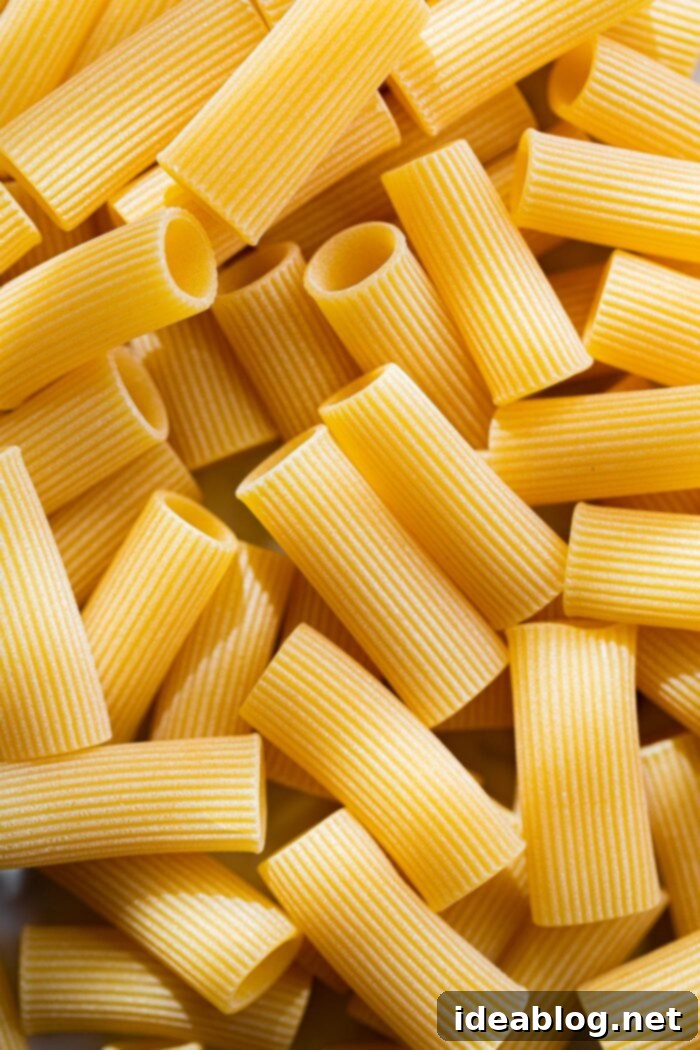
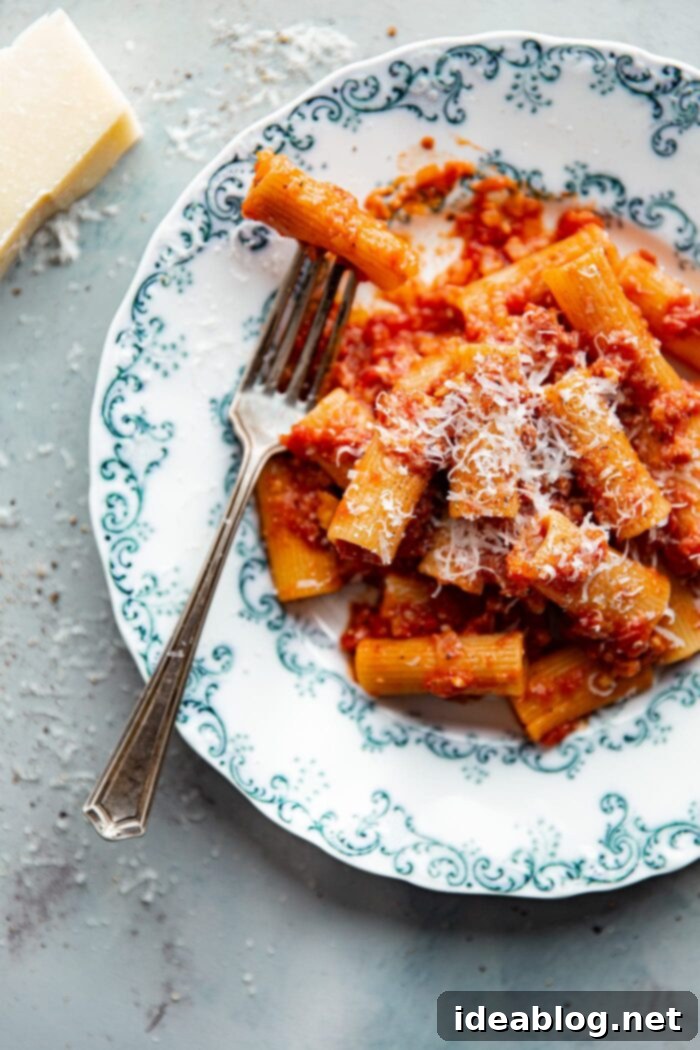
Choosing the Perfect Pasta for Your Amatriciana
While the sauce is undoubtedly the star of Amatriciana, the choice of pasta plays a crucial supporting role in ensuring a truly satisfying dish. Traditionally, long, thin pastas like bucatini or spaghetti are considered the classic pairing for Amatriciana. Bucatini, with its hollow center, is particularly adept at trapping sauce, offering a delightful burst of flavor with every bite.
However, I’ve developed a personal preference that you might also enjoy: rigatoni. This short, tubular pasta with its characteristic deep ridges and wide surface area is an excellent option. Its robust shape and textured exterior allow the rich, rustic Amatriciana sauce to cling exceptionally well, ensuring that each piece of pasta is generously coated with the savory tomato, crispy pancetta, and cheesy goodness. The ridges act like tiny channels, holding onto the sauce, while the larger opening of the tube captures small bits of pancetta and onion, delivering a fantastic textural experience.
It’s also important to note that, unlike a fresh egg pasta often used in dishes like this Creamy Leek and Pancetta Pappardelle, Pasta Amatriciana truly shines when prepared with dried pasta. For the best results, look for high-quality dried pasta that has been “bronze die-cut.” This traditional method creates a rougher, more porous surface on the pasta, allowing it to absorb and grip the sauce more effectively than smoother, modernly extruded varieties. This small detail can make a big difference in how well your Amatriciana comes together.
Step-by-Step Guide: How to Master Amatriciana Sauce
Creating this flavorful Amatriciana sauce is a straightforward process, built on layering ingredients to achieve maximum depth and richness. Follow these steps for a perfect Italian weeknight meal:
- Heat a large (12-inch) skillet over medium heat, then add the extra virgin olive oil. Once shimmering, add your diced pancetta. Cook the pancetta patiently, stirring occasionally, until it renders its fat, becomes beautifully golden brown, and delightfully crispy, which usually takes about 5 to 7 minutes. The rendered fat is liquid gold, so leave it in the pan! Using a slotted spoon, carefully remove the crispy pancetta pieces and transfer them to a small bowl to set aside. This step ensures the pancetta stays crisp and doesn’t get soggy in the sauce.
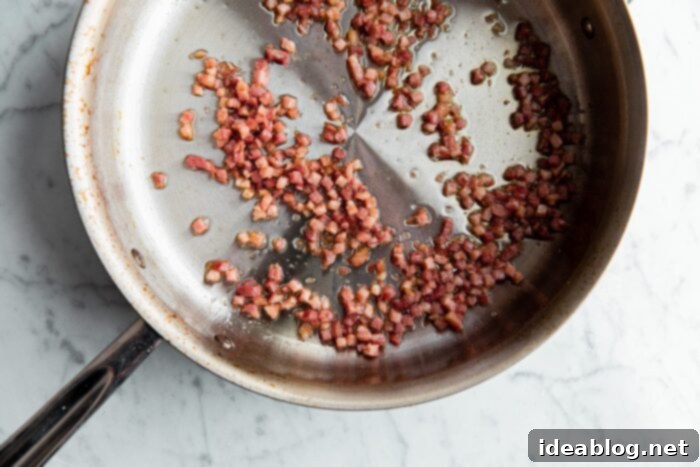
- Into the same skillet with the rendered pancetta fat, add the finely diced yellow onion, crushed red pepper flakes, and a generous pinch of kosher salt. Cook this aromatic base over medium-low heat, stirring frequently, until the onions soften significantly, become translucent, and just begin to take on a hint of golden color, typically 5 to 7 minutes. This slow cooking allows their sweetness to develop. Next, add the sliced garlic and cook for another 1 to 2 minutes, stirring constantly, until it becomes fragrant. Be careful not to let the garlic brown or burn, as this can impart a bitter taste.
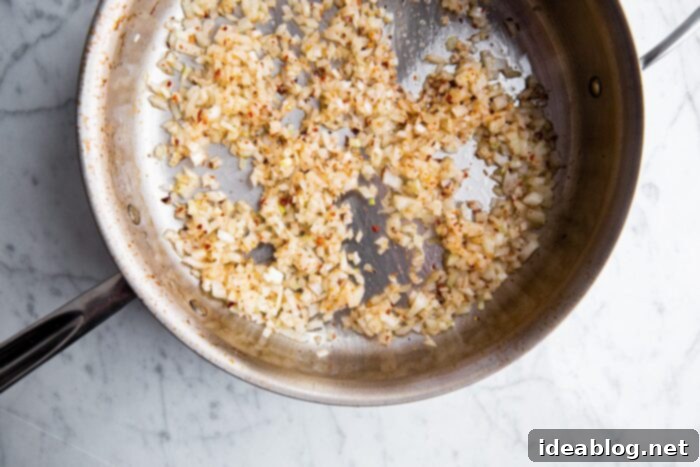
- Add the tomato paste to the skillet. Cook the tomato paste, stirring constantly to prevent scorching, for about 2-3 minutes. You’ll notice it start to darken in color and develop a deeper, more concentrated aroma – this caramelization step is key for rich flavor. Now, pour in the canned Italian tomatoes and return the reserved crispy pancetta to the skillet. Stir thoroughly until all the ingredients are evenly incorporated. Bring the sauce to a gentle simmer, then reduce the heat to low, and let it cook for an additional 15 to 20 minutes. This simmering time allows the flavors to meld beautifully. Taste and season with additional salt and freshly ground black pepper as needed.
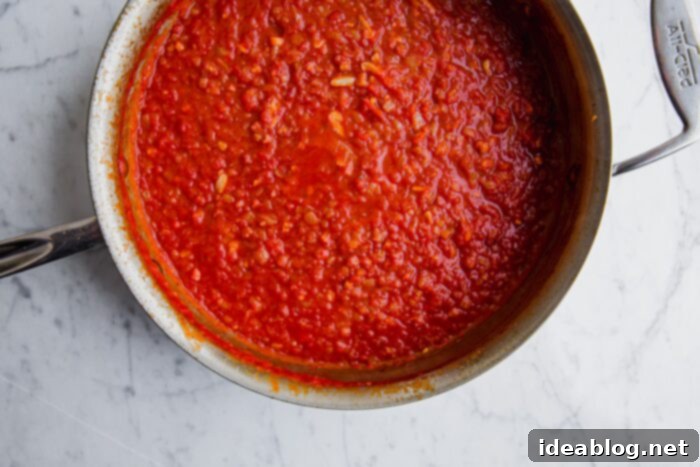
- While your sauce is simmering, bring a large pot of salted water to a rolling boil. Add your chosen pasta (rigatoni, bucatini, or spaghetti) and cook until it is just shy of al dente – meaning it should still have a slight bite. This is crucial because the pasta will finish cooking in the sauce. Using a spider skimmer or a large slotted spoon, transfer the pasta directly from the boiling water into the skillet with the Amatriciana sauce. With the pan still over low heat, add the finely grated Pecorino Romano cheese and a generous splash or two of the starchy pasta water. The pasta water helps to emulsify the sauce, creating a silky, luscious texture that clings perfectly to the pasta. Toss vigorously until the pasta is evenly coated and cooked to a perfect al dente. Serve immediately, topping each plate with additional finely grated Pecorino Romano cheese and a sprinkle of fresh parsley, if desired.
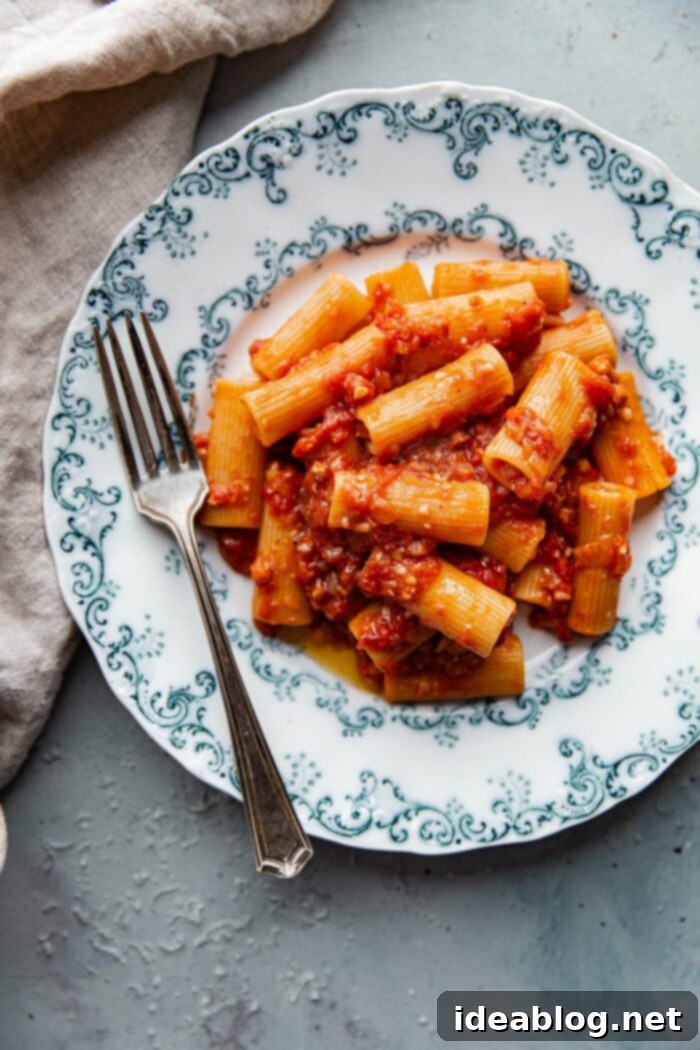
Tips for Amatriciana Success:
- Quality Ingredients Matter: With a simple recipe like Amatriciana, the quality of your ingredients truly shines through. Invest in good canned San Marzano tomatoes, fresh pancetta (or guanciale if you can find it), and real Pecorino Romano cheese.
- Don’t Rush the Pancetta: Allowing the pancetta to slowly render its fat and become crispy is essential for flavor and texture. This foundation sets the tone for the entire sauce.
- Cook the Tomato Paste: The quick sauté of tomato paste isn’t just about mixing; it’s about developing its deep, sweet, and umami flavors, which adds significant complexity to the final sauce.
- Pasta Water is Your Friend: The starchy pasta water is key to achieving a luscious, emulsified sauce that coats the pasta beautifully. Don’t throw it all out!
- Taste and Adjust: Always taste your sauce before serving. Adjust salt, pepper, or even a tiny bit more red pepper flakes if you want more heat. Remember, Pecorino Romano is quite salty, so factor that in.
- Serve Immediately: Amatriciana is best enjoyed fresh off the stove when the pasta is perfectly coated and the flavors are at their peak.
Serving Suggestions and Variations:
To complete your Italian feast, serve your Pasta Amatriciana with a simple green salad dressed with a vinaigrette to cut through the richness of the sauce, and a side of crusty Italian bread to sop up every last drop. For a fresh touch, a sprinkle of finely chopped fresh basil or parsley just before serving can add a vibrant aroma and color.
While the recipe uses pancetta, if you can source authentic *guanciale*, it will elevate the flavor to another level, offering a more profound richness and a distinct, peppery note. Some regional variations of Amatriciana include a splash of dry white wine or a touch of hot pepper before adding the tomatoes, which you could experiment with if you’re feeling adventurous.
If you enjoy this recipe, you might also like:
- Creamy Leek Pancetta Pappardelle
- Roasted Tomato Spaghettini with Garlic Breadcrumbs
- Slow Cooker Bolognese Sauce
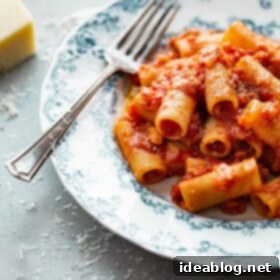
Classic Pasta Amatriciana
Pin
Review
SaveSaved!
While bucatini or spaghetti are traditional choices for Amatriciana, rigatoni has become my personal favorite due to its unique ability to capture and hold the robust sauce. The deep ridges and large surface area of rigatoni allow the textured sauce to cling exceptionally well, ensuring a burst of flavor in every bite.
Ingredients
- 1 tablespoon extra virgin olive oil
- 4-6 ounces pancetta (Italian bacon) cut into a small or medium dice for even distribution and crispiness
- 1 small yellow onion (roughly 6-7 ounces) finely diced to melt into the sauce
- 1 teaspoon crushed red pepper flakes or ½ teaspoon for less heat, adjust to your preference
- kosher salt I recommend Diamond Crystal brand, for seasoning throughout
- 3 garlic cloves finely sliced or minced for fragrant flavor
- 2 tablespoons tomato paste
- 1 (28-ounce) can crushed San Marzano or Italian plum tomatoes or high-quality canned whole Italian tomatoes, processed until mostly smooth
- freshly ground black pepper to taste
- 1 lb (16 ounces) rigatoni, bucatini, or spaghetti preferably bronze die-cut for best sauce adherence, see recipe headnote for recommendations
- 1 ounce finely grated pecorino romano cheese (roughly ¼ cup) plus more for serving, essential for authentic flavor
Instructions
-
Heat the olive oil in a large (12-inch) skillet over medium heat. Add the pancetta, spreading it in an even layer. Cook until the pancetta is fully rendered, golden brown, and crispy, which typically takes about 5 to 7 minutes. Using a slotted spoon, carefully remove the crispy pancetta pieces and transfer them to a small bowl. Set aside the crispy pancetta, leaving all the delicious rendered fat behind in the skillet – this fat is crucial for flavoring the sauce base.

-
Add the finely diced onion, crushed red pepper flakes, and a generous pinch of kosher salt to the pan with the rendered fat. Cook over medium-low heat, stirring often, for about 5 to 7 minutes, until the onions become very soft, translucent, and just begin to develop a slight golden color. Next, add the sliced garlic and continue to cook for 1 to 2 minutes, stirring constantly, until it becomes wonderfully fragrant. Ensure the garlic doesn’t burn, as this can impart bitterness.

-
Stir in the tomato paste and cook, continuing to stir constantly to prevent it from scorching, until the tomato paste has deepened in color and started to cook down slightly, about 2-3 minutes. This step concentrates its flavor. Then, add the canned crushed tomatoes and return the reserved crispy pancetta to the skillet. Stir the sauce well until all the ingredients are thoroughly incorporated. Bring the sauce to a gentle simmer, then reduce the heat to low and let it cook for an additional 15 to 20 minutes, allowing the flavors to meld and develop. Taste and season to perfection with additional salt and freshly ground black pepper as needed.

-
Meanwhile, cook your chosen pasta in a large pot of generously salted boiling water until it is just shy of al dente. This ensures the pasta finishes cooking perfectly in the sauce. Using a spider skimmer or a large slotted spoon, transfer the pasta directly from the boiling water into the skillet with the Amatriciana sauce. With the pan still over low heat, add the finely grated Pecorino Romano cheese and a generous splash or two of the starchy pasta water as needed to help loosen the sauce and create a beautiful emulsion. Toss everything together vigorously until the sauce evenly coats every strand or piece of pasta. Serve immediately, topping with additional finely grated Pecorino Romano cheese and a touch of fresh parsley, if desired.
Tips for Success:
- This recipe calls for 1 teaspoon of dried red pepper flakes. This amount provides a decent, noticeable warmth and subtle heat without overpowering the palate. Of course, if you are sensitive to spicy foods, decrease the quantity to 1/2 teaspoon or less, and simply adjust to taste. For a bolder kick, feel free to add a little more!
- Use Quality Ingredients: With such a simple ingredient list, the quality of each component truly matters. Opt for good quality canned tomatoes (San Marzano if possible), fresh pancetta, and authentic Pecorino Romano cheese for the best flavor.
- Reserve Pasta Water: Don’t forget to reserve some starchy pasta water! It’s invaluable for achieving the perfect consistency and helping the sauce cling to the pasta.
- Cook Pasta Al Dente: Since the pasta will finish cooking in the sauce, ensure it’s slightly undercooked when you transfer it. This prevents mushy pasta and allows it to absorb more flavor.
